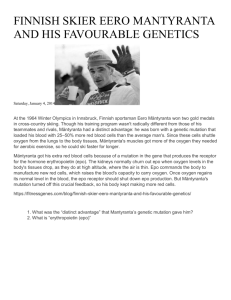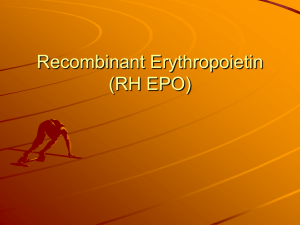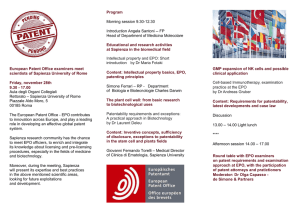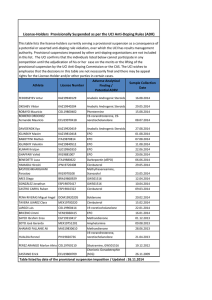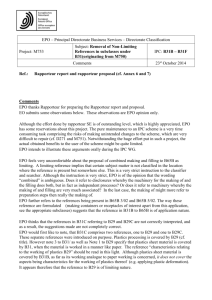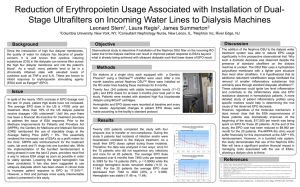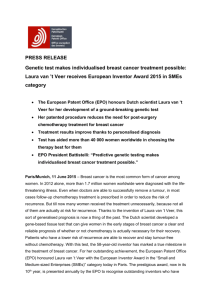Educational Course Objectives
advertisement
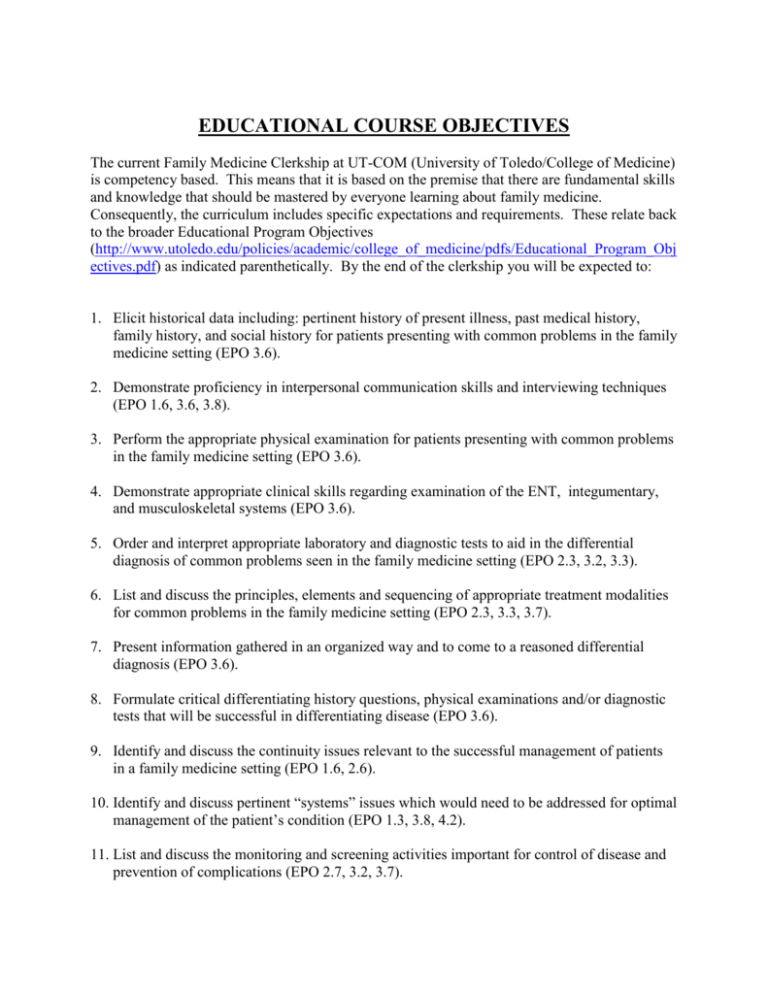
EDUCATIONAL COURSE OBJECTIVES The current Family Medicine Clerkship at UT-COM (University of Toledo/College of Medicine) is competency based. This means that it is based on the premise that there are fundamental skills and knowledge that should be mastered by everyone learning about family medicine. Consequently, the curriculum includes specific expectations and requirements. These relate back to the broader Educational Program Objectives (http://www.utoledo.edu/policies/academic/college_of_medicine/pdfs/Educational_Program_Obj ectives.pdf) as indicated parenthetically. By the end of the clerkship you will be expected to: 1. Elicit historical data including: pertinent history of present illness, past medical history, family history, and social history for patients presenting with common problems in the family medicine setting (EPO 3.6). 2. Demonstrate proficiency in interpersonal communication skills and interviewing techniques (EPO 1.6, 3.6, 3.8). 3. Perform the appropriate physical examination for patients presenting with common problems in the family medicine setting (EPO 3.6). 4. Demonstrate appropriate clinical skills regarding examination of the ENT, integumentary, and musculoskeletal systems (EPO 3.6). 5. Order and interpret appropriate laboratory and diagnostic tests to aid in the differential diagnosis of common problems seen in the family medicine setting (EPO 2.3, 3.2, 3.3). 6. List and discuss the principles, elements and sequencing of appropriate treatment modalities for common problems in the family medicine setting (EPO 2.3, 3.3, 3.7). 7. Present information gathered in an organized way and to come to a reasoned differential diagnosis (EPO 3.6). 8. Formulate critical differentiating history questions, physical examinations and/or diagnostic tests that will be successful in differentiating disease (EPO 3.6). 9. Identify and discuss the continuity issues relevant to the successful management of patients in a family medicine setting (EPO 1.6, 2.6). 10. Identify and discuss pertinent “systems” issues which would need to be addressed for optimal management of the patient’s condition (EPO 1.3, 3.8, 4.2). 11. List and discuss the monitoring and screening activities important for control of disease and prevention of complications (EPO 2.7, 3.2, 3.7). 12. Identify and discuss the important “physician coordination” issues that would need to be addressed for optimal management of the patient’s condition (EPO 1.3, 3.8). 13. Identify, list and discuss the important economic issues which would need to be addressed to optimize the management of the patient’s condition (EPO 3.7). 14. Describe the role of the family physician related to women’s health issues (1.7, 3.2, 3,3, 3.6, 3,7). 15. Identify and discuss ethical issues encountered in family medicine (EPO 2.6). 16. Identify important patient concerns when caring for geriatric patients in ambulatory and extended care facility settings (EPO 1.6, 1.7, 2.6). 17. Demonstrate awareness of the issues relevant to providing medical care for diverse, at-risk populations, specifically, mentally retarded/developmentally delayed (MR/DD) patients, including communication, interpersonal and physical exam skills as well as respect for patient autonomy (EPO 1.7, 4.1). 18. Students will be able to evaluate common injuries seen in a Family Medicine setting. EPO 3.3-3.5). 19. Describe strategies involved in educating patients for behavior changes (EPO 2.7). 20. Explain the impact of psychosocial factors on health and illness (EPO 2.6). 21. Demonstrate knowledge and application of evidence-based medicine (EPO 2.5). 22. Meet or exceed the institutional standards for professional behaviors as described in the Clerkship Manual (EPO 1.1-1.7). CASE LOGS To help learners achieve the Educational Course Objectives, requirements for both patient type (diagnostic category) and students’ level of involvement have been established. Students are expected to log both patient type and level of involvement for their patient encounters. Patient type: During this clerkship, students are required to evaluate patients in the following diagnostic categories representing the common problems seen in a family practice setting. This provides the core of the family medicine experience. Most patients will be seen in ambulatory settings. Students must log all patient encounters and logs will be monitored daily to ensure adequate experience. If multiple problems are addressed with one patient at a given encounter, then up to four appropriate diagnostic categories can be entered for that patient. Diagnostic category Cardiovascular disease Dermatologic disorders Endocrine disease Female genitourinary Gastrointestinal disease Male genitourinary Musculoskeletal disease Neurologic Other Preventative care Psychiatric Respiratory disease/ENT disorders Societal issues Number of Patients to be seen 2 2 2 2 2 2 2 2 2 2 2 2 2 Diagnostic category inclusions: Cardiovascular disease: hypertension, arrhythmia, coronary artery disease, congestive heart failure, angina, chest pain Respiratory disease/ENT disorders: allergic rhinitis, asthma, URI, bronchitis, sinusitis, COPD, cough Gastrointestinal disease: dyspepsia, GERD, constipation, diarrhea, irritable bowel disorder, hemorrhoids, rectal pain, liver disorder, dysphagia Musculoskeletal disease: including strains, sprains and fractures Upper Torso: neck pain, shoulder pain, rib pain, arm, elbow, wrist pain Lower Torso: hip pain, knee pain, back pain, ankle pain, and foot pain Endocrine disease: diabetes, thyroid, osteoporosis, obesity Female Genitourinary: menopause, menstrual disorders, breast disorders, bladder disorders Male Genitourinary: prostate, bladder, testicular disorders, impotence Psychiatric: depression, anxiety, panic disorder, bipolar disorder, ADD, ADHD, dementia Neurologic: dementia, stroke, headache, neuropathic pain, restless leg syndrome, seizures ENT disorders: otitis media, otitis externa, nasal congestion, pharyngitis, tonsillitis Dermatologic disorders: acne, tinea pedis, onychomycosis, rashes, lesions (benign and malignant) Societal issues: cultural issues in care, tobacco use, alcohol abuse, obesity, domestic violence Preventative care: well visits, immunizations, recommendations for cancer screening, nutrition counseling, exercise counseling Other: fatigue, insomnia, fibromyalgia, chronic pain If you are unsure of the appropriate category for a given diagnosis, you can discuss it with your preceptor or with the Clerkship Director. Student involvement: Students' participation in the patient encounters involves: independently eliciting patient history information performing physical exam under direct preceptor supervision suggesting diagnostic tests suggesting treatment options verbally describing the pathophysiology of common disease processes providing patient education under the supervision of the preceptor Students are required to use the electronic, web-based database to keep a log of patient work ups documenting the types of patients seen and the level of responsibility. Procedures may also be logged. Students are expected initially to log in to the meded portal for each patient they encounter, and up to four diagnoses can be entered for each patient. Once the required cases have been entered (i.e. two per diagnostic category), students are expected to enter two patient encounters per day. Students are encouraged to log cases that are particularly interesting or educational. One can still enter them on a weekly basis, i.e.: all ten cases for the week can be entered on Sunday. The expectation is that by Monday morning of each week the cases will be updated. Failure to comply with these requirements will result in communications from the Coordinator or Director, and if a pattern develops this will result in both a loss of points on the Clerkship Educational Program and a Professionalism Behavior Report. In addition to required clinical experiences (patient type and level of involvement), successful completion of the clerkship requires student participation in a variety of additional experiences. These experiences are coordinated through the Department of Family Medicine and include lecture/discussions, completion of online modules, and written projects.
